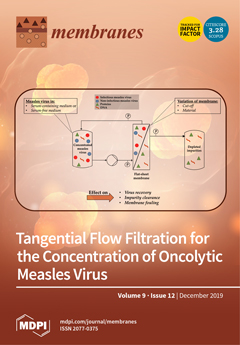The effect of carbonic anhydrase (CA) on the separation performance of thin poly(amidoamine) (PAMAM) dendrimer/poly(ethylene glycol) (PEG) hybrid membranes was investigated. CA, a type of enzyme, was used to promote CO
2 hydration and dehydration reactions and to assess whether these reactions were
[...] Read more.
The effect of carbonic anhydrase (CA) on the separation performance of thin poly(amidoamine) (PAMAM) dendrimer/poly(ethylene glycol) (PEG) hybrid membranes was investigated. CA, a type of enzyme, was used to promote CO
2 hydration and dehydration reactions and to assess whether these reactions were the rate-limiting step in CO
2 permeation through the membrane. The relationship between the membrane thickness and the CO
2 permeance was evaluated in CO
2/H
2 or CO
2/He separation using PAMAM/PEG hybrid membranes (thickness: 10–100 μm) with and without CA. Without CA, the CO
2 permeance of PAMAM/PEG hybrid membranes was not inversely proportional to the membrane thickness. On the other hand, with CA, the CO
2 permeance was inversely proportional to the membrane thickness. It was implied that, without CA, the rate-limiting step of CO
2 transport was either the CO
2 hydration reaction at the feed side or the CO
2 dehydration reaction at the permeate side. On the other hand, with CA addition, the rate-limiting step of CO
2 transport was diffusion, and CO
2 permeance could be increased without sacrificing the selectivity by reducing membrane thickness. The effect of the position of CA (i.e., on the surface and/or reverse surface) on CO
2 separation performance was investigated to evaluate which reaction was the rate-limiting step of CO
2 permeation through the membrane. It was suggested that the rate-limiting step of CO
2 permeation was CO
2 dehydration reaction at the permeate side.
Full article






